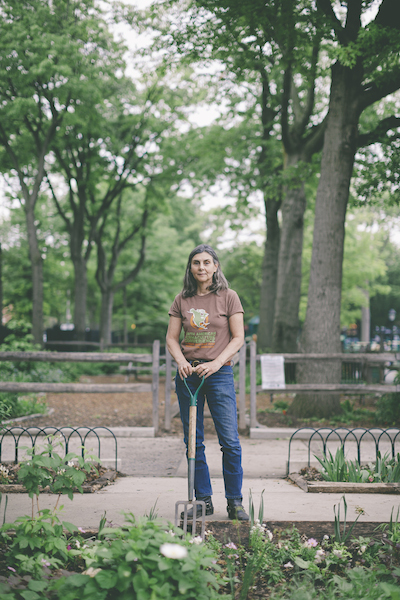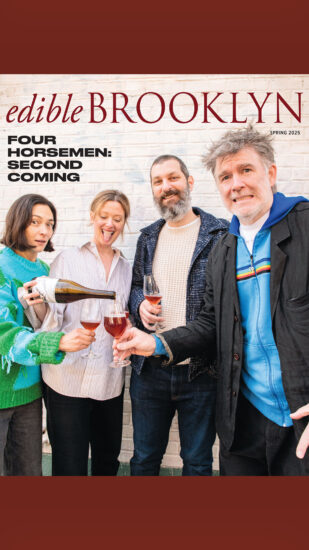PARK SLOPE—Most here know the Old Stone House and surrounding park as a destination where flash-mobs of neighborhood kids flit through sprinklers and burn off Culture fro-yo on the jungle gym. Some also know it as a site of the largest battle of the Revolutionary War; fewer know the stone structure was the clubhouse for an early incarnation of the Brooklyn Dodgers. But gardeners and songbirds know the site as one of the city’s only permaculture food forests.
Coined in the 1970s as a portmanteau of “permanent” and “agriculture,” permaculture is a whole-systems design approach modeled on nature — think of a forest or jungle that needs no watering can, packet of seeds or bag of fertilizer. Where ecologists aim to lessen our footprint, permaculturists seek a positive footprint, working to actually strengthen a given environment. And right here, across from the Washington Park Skate Park, a permaculture gardener named Claudia Joseph is doing exactly that.
Thanks to Joseph, greenery here includes the likes of okra, callaloo and chard, while the varied botany dotting the three-acre park provides much-needed feasting for migrating songbirds and pollinators like bees and butterflies. Raspberry, cranberry and elderberry bushes abound, lovingly tended by Joseph since 2004 when she set to work applying permaculture principles to the asphalted site.
Permaculture has transformed deserts into oases, wastelands into Edens and, in the Old Stone House’s case, urban blacktop into a wildlife-supporting space. A decade ago, this block was a landscape of broken-up asphalt, sparse lawn separated by chain link fencing and a couple of swing sets. But in 2004, Kim Maier came on board as director. One of her first moves was to hire Joseph.
Well-designed permaculture systems are set up to require as little effort as possible. Think seed saving, on-site composting, rainwater catchment and perennial plants that return on their own. Permaculture also aims to have energy needs provided by the immediate environment — like using a fallen tree for mulch or harnessing teenager energy for breaking down an old site.
Joseph’s inaugural project was a Colonial kitchen garden. “It’s not restoration,” she says. “We’re not putting back the swamp that was here in 1699. But we’re reinterpreting the concept of a useful landscape. We’re not ornamenting the landscape, although it is beautiful. We’re making the landscape function.”
School field trips introduce kids to history, gardening, plant identification and composting. One adorable OSH program called Traditional Medicinals pretends one of the original inhabitants of the house has an illness and the children are sent on a scavenger hunt to find its curative medicinal herb.
“They learn to make poultices, they make mint tea,” says Maier. “It’s really cool. So much classroom learning involves kids having to sit still for a long period of time, regurgitating a lot of information… And so many kids just don’t have a chance to get their hands dirty.”
Well-designed permaculture systems are set up to require as little effort as possible. Think seed saving, on-site composting, rainwater catchment and perennial plants that return on their own.
Adult class programming also allows for getting hands dirty and has included permaculture design, composting, natural dyeing and seed-saving workshops. A hearth-cooking meetup uses herbs from the gardens.
But much of the education that takes place here is informal. According to Joseph, parkgoer response to a wilder shrub like elderberry has been, “That looks like a weed.” To which she responds, “but it has delicious berries and it supports wildlife. You know, songbirds.” She relates how the site’s gone from zero butterflies to eight different kinds, and a light of understanding comes on.
Much of the capital improvement is happening under the auspices of Brooklyn Parks, City Parks and Council and Assembly members, including former Councilmember Bill de Blasio. But the community plays as vital a role in permaculture’s systems as soil and sun. “It’s not just the planting of the plants here, it’s the social structure that supports it,” says Joseph. “My neighbors or school kids come and help.”
This daily engagement connects across different sectors of society. Small children watch volunteer gardeners intently, lobbing questions, positing theories. Teenage basketball players pass by another section, “You all composting?” they ask, nodding approvingly.
“We have a huge caregiver community that comes from the islands,” says Maier. “They all have agricultural backgrounds, love the plants, understand what’s going on and can talk about different ways of cooking the foodstuffs that are grown in the garden.” Adding, “They have a sense of ownership in the space that they might not have otherwise.”
In fact the whole thing might not have happened without Jospeh.
“Claudia can create a garden out of nothing,” says Maier. “She starts and a month later it’s a garden.”



